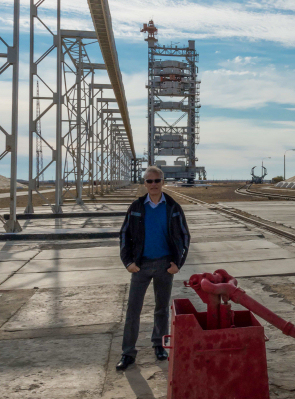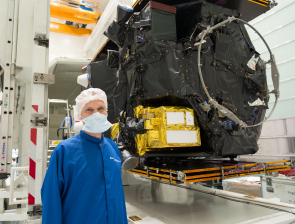An interview with Boris Bethge, Senior Assembly, Integration and Verification (AIV) Engineer for ExoMars
 |
|
Boris Bethge at the Proton launch site. Credit: Thales Alenia Space - Italy |
The first mission of ESA's ExoMars programme, which is scheduled to arrive at Mars in October 2016, consists of the Trace Gas Orbiter (TGO) plus Schiaparelli, the entry, descent and landing demonstrator module.
The AIV Systems Engineer for ExoMars 2016 is Boris Bethge. We asked Boris to tell us more about his background and his work on the mission to Mars.
How did you get to work at ESA?
Towards the end of my electrical engineering studies at the University of Siegen in Germany, I read a newspaper advertisement, which said that ESA was recruiting in various engineering disciplines. I contacted ESA and was invited to apply for their Young Graduate Training programme. After I was selected, I spent one year in ESTEC – the European Space Research and Technology Centre in Noordwijk, the Netherlands – before taking a job offer at MBB/ERNO (today's Airbus Defence and Space).
Many years later, I was working at NASA's Johnson Space Center in Houston, as part of an international team developing a future 'lifeboat' for the International Space Station (ISS). After our part in this project came to an end I began to look for a new project. Eventually I applied for a position as a software engineer for ESA's Columbus module, and went to work for the Agency for the second time.
What other space projects have you worked on, either in industry or at ESA?
I was involved with Columbus in various positions that dealt with software development, onboard computer development, electrical and software testing, and ISS interfaces definition and verification.
I also worked on the Data Management System for the Russian Service Module, part of the ISS, covering software, system testing and integration support. Another project was the Standard Payload Computer for ISS payloads, for which I was covering system and electrical engineering, as well as customer support.
During the X-38 programme to develop an experimental predecessor for the ISS Crew Return Vehicle, I was an avionics engineer and sub-project leader for the fault tolerant GNC (guidance, navigation and control) computer system. In addition, I had the chance to give limited support in my areas of expertise (onboard computer, software and AIV) to various other projects, including the European Automated Transfer Vehicle.
What are your interests outside of work?
I like to travel and explore this beautiful planet which I sometimes combine with my sporting interests, such as skiing, windsurfing, sailing or travelling around with my bike. On other occasions, the focus of my trip is on cultural activities like visiting museums or concerts. Besides this, I like to spend some social time with family and friends, and I enjoy reading and photography.
What are your main responsibilities on ExoMars?
Initially, I was instrumental in defining, together with my colleagues, the set of requirements for assembly, integration and verification (AIV) to be implemented on all levels of the ExoMars programme.
Following this, we discussed requirements with industry, and I had to see that these requirements were properly transferred by our contractors into a set of agreed plans and procedures, detailing exactly the models to be built, the assembly flow and the tests to be carried out in order to assure proper verification and workmanship.
I also had to oversee the procurement of the electrical ground support equipment necessary for the execution of the assembly, integration and test (AIT) programme on the various test and flight models.
 |
| Boris Bethge, in front of the ExoMars Trace Gas Orbiter. Credit: ESA - A. Haldemann |
During the last two years my job has been mainly to supervise the practical execution of all the planning on the industrial side for the modules of the ExoMars 2016 mission. Being co-located at Thales Alenia Space France in Cannes for most of the time since February 2014, I have followed the assembly and testing of the Trace Gas Orbiter on a daily basis.
In March last year the orbiter was joined by the Turin-built entry, descent and landing demonstrator module – called Schiaparelli – to form the spacecraft composite. We ran an extensive environmental and functional test programme on the spacecraft composite, then separately on the individual spacecraft (Trace Gas Orbiter and Schiaparelli), and then once more on the spacecraft composite, finishing at the end of 2015.
Following the transport of the modules just before Christmas to the launch site in Baikonur, my current duties as part of the ESA-industry launch campaign team are now focused on supporting the final check-outs and tests, assembly with the Proton launch vehicle and finally the launch, now planned for mid-March. In addition, I have also had to support the verification of part of the ground segment and the formal project reviews during its life cycle.
What have been the highlights and the challenges in shepherding the ExoMars modules through the AIV stage?
Certainly, the main highlight for me was to observe the plans turning into reality during the last two years, finally creating a real spacecraft, which is about to be launched. Working with the dedicated industrial AIT team, who achieved this despite all schedule pressure in a calm and professional manner, was a great experience and a real pleasure for me.
During this phase we found some technical issues that we had to solve, but a real challenge earlier was to adapt the AIV programme to the ever-changing evolution of ExoMars. It started as a European-only project with a lander and a rover on a single launcher, then went through various iterations in cooperation with NASA-JPL, before evolving into the current programme with our Russian partners, which now comprises two launches and five modules: the Trace Gas Orbiter and Schiaparelli which form the ExoMars 2016 mission, and the rover, surface platform and the carrier module of our next ExoMars mission.
 |
|
Biosampling Schiaparelli. Credit: ESA - B. Bethge |
Unfortunately, all these changes caused some delay and went together with severe budget constraints, sometimes leading to reduction of the models and the test programmes. The challenge was to implement this without compromising the overall goal of having a properly qualified spacecraft in the end.
A major challenge during the integration, especially of Schiaparelli, has been the need to keep the spacecraft as clean as possible from all microbiological life. If we ever find forms of life on Mars, we want to be certain that we have not brought it there ourselves. Therefore, a set of strict planetary protection requirements has been defined.
Their implementation means that we have to sterilise all units of the spacecraft, the tools we use and the cleanroom assembly environment itself. To maintain these conditions we have brought a special tent, which receives its own filtered air, and installed it within the normal cleanroom in Baikonur. We also have taken a microbiological laboratory with us and installed it in Baikonur, to perform regular measurements of the so-called bio-burden, so that we know if, and where we have to clean and re-sterilise.
What is it like to work in an international team?
Having worked in international teams for most of my career, it became kind of normal for me. Sometimes, when working with our industrial partners, I can observe teams of a single nationality, with their specific working cultures, their strengths and weaknesses. I found that the personality of the team members is much more important than the nationality when it comes to form a good team. However, by mixing the cultures, you get the chance to learn different aspects from each other. This is quite enriching for me and it opens the mind to consider the differences. I've found that usually there are many more things in common than might seem at first sight.
What inspires you about Mars and the ExoMars programme?
I am excited about Mars because it is our most Earth-like neighbour in space. Looking at the night sky, it can easily be seen, and when looking at pictures from its surface, the view is difficult to distinguish from photos taken in deserts on Earth.
When I was still at school, the Viking probes landed on the Martian surface in 1976 and I remember that I was so curious to see what it looked like, that I went and bought a scientific magazine, just to have the good quality prints of the photos taken from the surface. TV quality back then was not really good enough.
I looked at the photos and wondered how it would be to stand there myself, but I was fascinated by the possibility to send probes to places one could not yet go and look around and perhaps use tools, as if you were there. Helping to implement and improve such capability is really fascinating for me and it's part of what has led me to ExoMars. Another exciting aspect for me of ExoMars is that we implement it through technical and scientific international cooperation, something that really broadens the horizon.
What are you most looking forward to finding out with ExoMars?
Beyond our goal to see if ExoMars is able to find some form of life, it will be thrilling for me to learn if the ExoMars modules will actually perform as we have intended.
What is your vision or hope for the future of the mission?
To launch on time on 14 March, successfully land on 19 October on Mars and to return plenty of good scientific and engineering data from both the Trace Gas Orbiter and Schiaparelli. I hope we will also make exciting discoveries with the rover a few years later, which will inspire the Agency and its partners to pursue and enhance Mars exploration, with the long-term goal to land humans there in the not too distant future.



